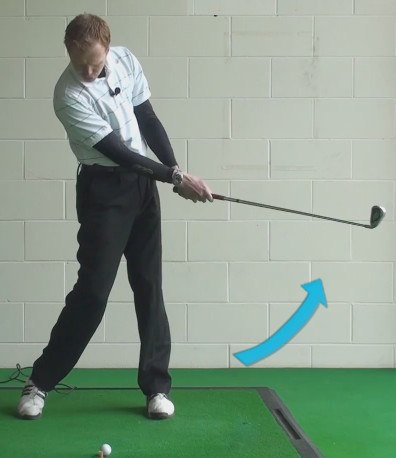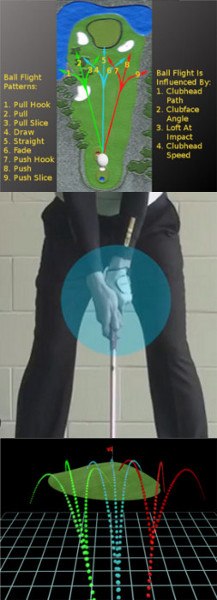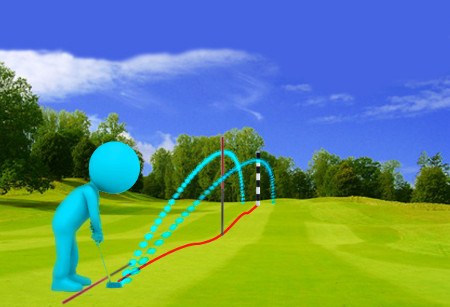
Has any golfer ever gotten more from less than Corey Pavin? Not likely.
Generously listed at 5'9” and 155 pounds by the PGA Tour, the slightly built Californian overcame a severe distance deficit and a decidedly non-textbook swing to win 15 PGA Tour events, including the 1995 U.S. Open. He's still going strong on the Champions Tour, claiming his first senior circuit victory in 2012.
Like most short hitters, Pavin wields a deadly putter and short game. But resourceful shotmaking is his true calling card. Pavin is a master at shaping shots, controlling spin and varying trajectory, which helps him compete with – and often beat – the game's longest hitters. As a great shot maker, Corey developed the ability to cure and fix many of his swing problems through a creative imagination.
Pavin's signature: A penchant for playing a wide variety of different shots with a swing that can best be described as “unorthodox.”
Who else does it: Chi Chi Rodriguez

To be blunt, Pavin's swing isn't pretty. He grips the club weakly, with his hands rotated to the left on top of the grip. He takes the club well past parallel at the top of the backswing, with a big hip and shoulder turn. On the follow-through, his arms fold abruptly while his head remains in place (down) well after contact, causing an awkward-looking finish.
Pavin's pre-shot routine is unusual, too. He's known for making a practice swing with an exaggerated “over-the-top” motion, which actually helps him get his arms in front of his body on the downswing. (Pavin's tendency is to get his arms “stuck” behind his body.)
Why it works for Pavin: It's hard to put a finger on what has made Pavin so successful. Certainly he has great hands, which allow him to manipulate the club and impart whatever spin he's after on a given shot. He's got sound fundamentals in the footwork, balance and rhythm departments, too.
But forgetting technique for a moment, it's clear that Pavin has the ability to envision effective shots, and the aptitude to bring his imagination to fruition. He's also comfortable playing his own game, using his strengths rather than trying to match the monster drives and towering iron shots of his peers. Of course, having the determination of a bulldog hasn't hurt this former UCLA star, called “the gritty little Bruin” by his many admirers.
John Jacobs, one of golf's greatest teachers, may have summed up Pavin best. “To me,” Jacobs said, “he's just a golfer.”
How it can work for you: If you're a short hitter like Pavin, the last thing you should do is try to play beyond your limitations. Don't worry about keeping up with big hitters. Instead, focus first on the short game – proficient putting and chipping don't require power and they almost always win the day, especially in the amateur ranks.
Next, learn which kinds of shots work best in different situations. For example, holes that dogleg (curve) to the right favor tee shots that bend in the same direction, a fade. Dogleg-left holes favor a draw. If you've got a long way to a green with no hazards in front, consider a low shot that runs onto the surface instead of swinging hard and hoping to carry the ball all the way there.
Finally, learn how to hit the ball left-to-right and right-to-left; how to hit it high and how to keep it low; and how to execute a bump-and-run and a flop shot. Not only will this arsenal help you overcome any physical shortcomings and beat stronger players, golf is often more interesting and fun when played with a creative approach.

Corey Pavin Shotmaking to Fit Any Situation
In his day, Corey Pavin was one of the toughest players to beat on the entire PGA Tour. Despite being one of the shortest hitters in the game, Pavin was frequently ranked in the top ten in the world, and he posted a top five finish in each of the four major championships - including a victory at the 1995 U.S. Open. In all, Pavin would win 15 times on the PGA Tour, and has since posted one victory on the Champions Tour. For someone who consistently had to play from well behind his competitors in the fairway, Pavin created an incredible career for himself that has spanned more than three decades.
So how has he done it? In an age of golf where power is the focus for so many players, Pavin has posted his scores through a combination of creative shotmaking and brilliant putting. To be sure, you can't shoot scores in the 60's as a short hitter if you don't make putts, and Pavin has made tons of putts throughout his career. However, it would be a mistake to simply chalk up his success to skill with the flat stick. In addition to his ability to handle the putter, it has been Pavin's ability to carve the ball around the course that has allowed him to compete on some of the world's toughest tracks.
There is a great lesson to be learned for the average golfer by taking a look at the career Pavin has built. Most amateurs are obsessed with hitting the ball farther, as they feel like that is the key to moving their scores lower in the years to come. However, Pavin stands as a perfect example of why that might not be the right way to approach the game. Instead of seeking more distance as his competition continued to hit it farther and farther, Pavin embraced what he did well and made it work beautifully. If you are not naturally a long hitter, your time and energy may be better spent learning how to master your own game as opposed to trying to do something that is outside of your comfort zone. You do not have to be a long hitter to be an excellent golfer, something that has been proven time and again by Corey Pavin over the course of his career.
In this article, we are going to focus on some of the basics of creative shotmaking that can help you make your way around the course. Good shotmaking is key for any golfer, but it is especially important for players who are unable to hit the ball particularly long or high. If you can't hit wedges into all of the par fours, you are going to need to work the ball into the green to get it close to the hole. Most players today don't think about the game in this way, as they simply try to hit the ball as high and straight as they can in order to go after the flag. If you are willing to be creative and learn how to carve the ball around a bit, you will find that the course opens up and there are many more opportunities out there than you might have imagined.
All of the content below is based on a right handed golfer. If you happen to play left handed, please take a moment to reverse the directions as necessary.

What is Shotmaking?
You will often hear the term 'shotmaking' thrown around at the golf course, but you may not know exactly what it means. Basically, golfers use the term shotmaking to describe a shot that is outside of a typical ball flight. For example, if you normally hit a high draw with your full swing, that would be considered your standard shot. On most holes, you will reach for that high draw and take dead aim right at the target. However, some holes will require you to break from that pattern, and that is where shotmaking comes into play. If you decide to hit a low cut to get the ball around a hazard and onto the green, most players would consider that to be 'shotmaking'. You would have gone outside of your comfort zone to create something specifically designed to deal with the situation at hand.
Sadly, shotmaking has somewhat disappeared in the modern game. Players like Pavin are harder and harder to find, as the equipment that is used today lends itself to hitting high, long, and straight shots. Golf balls don't curve as much as they used to, and club companies have gotten good at designing equipment that hits the ball in a straight line. While there is plenty of room for debate on whether or not this is a good thing for the game of golf as a whole, it cannot be debated that the game has changed. Shotmaking used to be a requirement if you wanted to post a good score - today, it is seen as something that is only used in desperate situations. Since the ball flies so high and stops so fast due to high spin rates, there simply isn't as much need for shotmaking as their used to be. Most of the time, you can just take dead aim and fire the ball right at the hole.
So, with that in mind, is it even worth it for you to learn how to create some unique shots on the course? Yes, it is. Shotmaking might not play the same role in the game that it once did, but it is still important for all golfers to know how to create shots that fall outside of their usual patterns. The course isn't always going to allow you to hit your normal shots, so having the ability to change things up on command is incredibly helpful. Even if you only hit two or three shots per round that fall into the shotmaking category, those shots could mean the difference between shooting a good score and shooting a disappointing one.
Looking beyond just the scorecard that you fill out at the end of the round, there is also an element of fun that should not be discounted here. Golf is supposed to be fun, after all, and the shotmaking shots that you produce during a round are likely to be the most memorable swings of the day. It can get repetitive, and even a bit boring, to hit the same shots over and over, even if those shots are leading to good results. However, shotmaking never gets boring, as each one is a new challenge. When you come up with a creative way to get your ball near the hole, and then it works, you will feel a sense of pride and accomplishment that is worth all of the effort that you invested in the shot. Simply put, learning how to hit a variety of shots can make golf more fun, and that should be the whole point in the first place.

Giving Yourself Options
Shotmaking is all about having options on the course. With that in mind, the first step toward becoming a shotmaker is understanding what kind of various shots may come in handy as you play a round of golf. The types of shots that you will want to hit are always going to depend on the kinds of course you are playing and the weather, but there are a few trajectories that seem to be useful again and again on a great number of courses. Take a look at the list below to gain an idea of what shots you would benefit from learning in your pursuit of improved shotmaking skills.
- A low runner. This is probably the standard shotmaking shot that you should have in your arsenal above all others. When a situation arises on the course that calls for a low shot which will run toward the target, you need to be able to come up with the right swing to make that happen. There are a number of reasons for wanting to hit a low shot, including wind, course conditions, hazards, and more. No matter why it is that you need to hit the ball low, it is a great feeling to know that you can do so when needed. Not all golfers have the control needed in the swing to keep the ball down, and those who do possess a big advantage over their competition.
- A big hook. This is a shot that is useful when there is an obstacle on the course that you need to make your way around. Usually, that obstacle is a tree - one that is too tall to go over. If you find your ball positioned in a spot that places a tree between you and the hole, hitting a big hook might be your only option. A hard hook is preferable to a big fade because you should be able to keep the hook lower than the fade - making it easier to get around (and under) the tree. Also, the hook will run out when it lands, meaning you can coax more distance from the shot. Obviously you don't want to put yourself in places that require big hooks very often, but having the ability to pull this shot out when needed can save you a stroke or two at a crucial point in your round.
- A soft fade. Hitting a fade on demand is great when you need to send the ball high up into the air and stop it quickly when it lands. This shot can be used when the hole is located near the right side of the green, or when the greens are firm and you are worried about a draw bouncing over the back. Players who consider themselves 'shotmakers' are regularly trying to cut the ball for control purposes, so this is a shot that you should get familiar with if at all possible. Also, having the ability to hit a soft fade means you should be able to hit a bigger fade on the rare occasion when that shot is needed.
- No spin wedge. The last shot on this list is what some golfers refer to as a no-spin wedge. Of course, that name is not particularly accurate, as all golf shots have some degree of spin. The idea here is that you hit a wedge shot with a low amount of backspin so that the ball takes a bounce or two before stopping. You can use this shot when you need to get the ball back to a hole location cut near the back edge of the green, or when you want to prevent the ball from spinning off the front edge of the green. Soft greens can present a challenge in terms of keeping your ball from spinning back too far, so hitting a little wedge with minimal spin will give you a good option for approach shots in soft conditions.
The list above only includes some of the shots that you can use when trying to make your way around the course. These are shots that are familiar to shotmaking-style players, but some golfers may not have even attempted to create some of these shots. By keeping an open mind and working on some of the flights listed above, you will open yourself up to a world of new options in your future rounds.

Getting Creative at the Right Time
Making good decisions is a big part of playing good golf. Corey Pavin hasn't been successful in golf only because he has been able to create a wide variety of shots – a big part of his success is owed to the fact that he could choose the right shot at the right time. There is no need to get creative when a 'standard' shot will do, and trying to do too much is a sure way to get in trouble. Therefore, you need to understand when the time is right to be creative, and when you would be better off just playing it straight.
The first thing to think about when it comes to shot selection is whether or not your standard shot will work for the shot at hand. That should always be your 'default' option – if your standard shot would be effective, stick with it and make your best swing. The shot that you use more frequently will always be your most reliable choice, so there is no reason to get fancy if a basic shot is capable of getting the job done. It is only when you are being forced by the course to get creative that you should reach into your bag of tricks for a shotmaking play.
The most obvious what that the course can force you into hitting a creative shot is by placing something in your way. Trees are the most-common form of obstacle that you will face, but there could also be a deep bunker that you have to go around or a big water hazard that can't be carried easily. These kinds of hazards will make it obvious that you need to hit a creative shot, so the choice to do so will be relatively simple. When faced with something that is plainly in your way, the only thing you can do is find a way around. If you have taken the time to learn how to hit some shotmaking ball flights, you can pick one of those options and create a shot that will allow you to access the target.
Decision making gets a little more difficult when you don't necessarily have to reach for a shotmaking shot. These are the times when a subtle piece of course design can get in your head. One great example of this kind of design is the false front. A false front is a section of green that will not allow the ball to hold. The grass is mown as part of the green, so it will look attractive to hit your ball there, but the ball will simply roll back off into the fairway (or rough…or worse). A false front is a 'trick' that will force you to think carefully about your plan for an approach shot. While this kind of design might not require you to use a ball flight that is different than your usual, you might want to think about using something like a no-spin wedge in order to avoid falling victim to the front. The most difficult shots you face on the course are usually not the ones with obvious hazards, but rather the ones with subtle obstacles that can quickly cause you to waste shots if you aren't careful.
Making good decisions with your shotmaking options is something that is going to take time and experience. Corey Pavin has a long career of experiences to look back on when he makes a shot choice, which is why he gets it right so often. You might not have that kind of professional pedigree, but you can still learn from your mistakes in order to get better as you go. As long as you think carefully about all of your options prior to hitting any shot, you should be able to make the right pick more often than not.

Practice Makes Closer to Perfect
You shouldn't expect to just pull creative shots out of your bag on the fly as you go around the course. Everything you do during a round of golf should be practiced in advance, from your regular swings on down to your shotmaking hooks and fades. Without practice, there is simply no way to know how a shot is going to come off, and that is a risk you can't afford to take during a round. Take some time on the range to hone your shotmaking skills in advance and you will be able to reach for these shots with confidence when the time comes to use them for real.
It is easy to fall into a pattern on the driving range of just making the same full swings over and over again, but that isn't going to do much for improving your play on the course. Instead of smashing ball after ball with the same swing, use some of your range time to work on shotmaking skills that will pay off on the course. Hit some shots softer than normal, hit some draws and fades, and hit some low-flighted shots that stay close to the ground. Adding variety into your practice sessions will not only help you learn how to create a variety of shots, but it will also make it easier for you to strike the ball cleanly with your full swing. You may be surprised to see how much you learn about your swing when you make alterations to it while trying to hit different types of shots. Carving the ball around the range is a great way to discover things about your game that you didn't know were there – it is hard to think of a better way to spend your time on the range than to be constantly trying to create new shots.
Golfers today often like to prepare for a round as if they are going to be playing in a vacuum. There is a lack of creativity in the modern game, which is why watching Corey Pavin is so enjoyable and refreshing. Pavin goes about the game in a unique way, and he posts great scores because of it. He has been willing to play like himself while the game changed around him, and that commitment to his own game as led to the reward of an excellent career. Even if you have no pro golf aspirations and you simply hope to lower your handicap from year to year, it is still important that you stick to your own game and avoiding the temptation to play like anyone else. Use your creativity, carve the ball around the course to the best of your ability, and enjoy every shot along the way.






